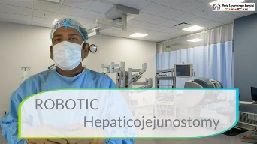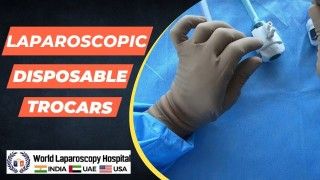Safest Total Laparoscopic Hysterectomy with Bilateral Salpingo-oophorectomy
Add to
Share
179 views
Report
10 months ago
Description
Total Laparoscopic Hysterectomy (TLH) with Bilateral Salpingo-oophorectomy is a common gynecological procedure performed to remove the uterus, fallopian tubes, and ovaries. As with any surgical intervention, patient safety is of utmost importance. In recent years, advancements in surgical techniques have focused on optimizing safety during TLH with Bilateral Salpingo-oophorectomy. This essay explores the significance and benefits of the safest approach to this procedure, emphasizing the importance of safeguarding surgical excellence and patient well-being. Total Laparoscopic Hysterectomy with Bilateral Salpingo-oophorectomy offers several advantages over traditional open surgery, including reduced postoperative pain, shorter hospital stays, faster recovery times, and improved cosmetic outcomes. However, ensuring patient safety during this procedure is a multifaceted endeavor that encompasses various aspects of surgical planning and execution. One crucial element in achieving the safest approach is meticulous preoperative evaluation and patient selection. Careful assessment of the patient's medical history, comorbidities, and individual risk factors allows for appropriate patient selection and customization of the surgical approach. Identifying any preexisting conditions that may increase surgical risks or complications enables the surgical team to develop tailored strategies to optimize patient safety. Intraoperatively, advanced techniques and technologies play a significant role in enhancing safety. The utilization of laparoscopic instruments, including high-definition cameras and precision surgical tools, allows for improved visualization and precise manipulation of tissues. This facilitates meticulous dissection, minimizing the risk of unintended tissue damage and bleeding. The integration of advanced energy devices, such as bipolar sealers or ultrasonic dissectors, further enhances safety by providing controlled tissue sealing and minimizing thermal injury. Another critical aspect of ensuring safety in TLH with Bilateral Salpingo-oophorectomy is the prevention of intraoperative complications. Careful identification and preservation of vital structures, such as the ureters and blood vessels, are paramount. Techniques like Ureteric Mapping using Indocyanine Green (ICG) or intraoperative Doppler ultrasound aid in visualizing and avoiding injury to these structures, reducing the risk of postoperative complications. Additionally, meticulous hemostasis and careful closure of incisions contribute to minimizing bleeding and infection risks. Postoperative care and follow-up are equally essential in the safest approach to this procedure. Adequate pain management, thromboprophylaxis, and early mobilization protocols help prevent complications and expedite recovery. Close monitoring and prompt management of any postoperative concerns or complications ensure optimal patient outcomes and satisfaction. By adopting the safest approach to TLH with Bilateral Salpingo-oophorectomy, patient safety is enhanced, and the risk of surgical complications is minimized. The application of advanced techniques, meticulous surgical planning, and comprehensive intraoperative care converge to safeguard surgical excellence. As a result, patients benefit from reduced risks, faster recovery, improved quality of life, and overall enhanced surgical outcomes. Moreover, continuous professional development and ongoing training for surgeons and the surgical team are fundamental to maintaining the safest approach. Staying up-to-date with the latest evidence-based practices, participating in surgical workshops, and fostering a culture of quality improvement contribute to ongoing excellence in patient care. Total Laparoscopic Hysterectomy (TLH) with Bilateral Salpingo-oophorectomy is a gynecological procedure performed to remove the uterus, fallopian tubes, and ovaries using minimally invasive techniques. The safety of patients during this procedure is of paramount importance, and advancements in surgical approaches have focused on optimizing safety and patient outcomes. This essay explores the significance of the safest approach to TLH with Bilateral Salpingo-oophorectomy, highlighting the key elements that contribute to safeguarding surgical excellence and prioritizing patient well-being. The safest approach to TLH with Bilateral Salpingo-oophorectomy encompasses various aspects of patient care, starting with meticulous preoperative evaluation and patient selection. Careful assessment of the patient's medical history, risk factors, and comorbidities enables the surgical team to tailor the surgical approach and minimize potential complications. A thorough understanding of the patient's individual needs and risks is essential in ensuring their safety and optimizing surgical outcomes. During the procedure, advanced laparoscopic techniques and technologies are employed to enhance safety. High-definition cameras and precision surgical tools allow for improved visualization and precise tissue manipulation, reducing the risk of unintended tissue damage. Energy devices, such as bipolar sealers or ultrasonic dissectors, provide controlled tissue sealing and minimize the risk of thermal injury. These advanced tools and techniques contribute to safer dissection and precise surgical maneuvers. Prevention of intraoperative complications is a crucial aspect of the safest approach. Identification and preservation of vital structures, such as the ureters and blood vessels, are paramount. Techniques like Ureteric Mapping using Indocyanine Green (ICG) or intraoperative Doppler ultrasound assist in visualizing and avoiding injury to these structures, ensuring patient safety. Meticulous hemostasis and careful closure of incisions further minimize the risk of bleeding and infection. Postoperative care and follow-up are essential components of the safest approach. Adequate pain management, thromboprophylaxis, and early mobilization protocols are implemented to prevent complications and facilitate recovery. Close monitoring and timely management of postoperative concerns or complications contribute to optimal patient outcomes and satisfaction. By adopting the safest approach to TLH with Bilateral Salpingo-oophorectomy, patient safety is prioritized, and the risk of surgical complications is minimized. Surgeons and the surgical team continuously engage in ongoing professional development and training to stay updated with the latest evidence-based practices and advancements. This commitment to excellence ensures the delivery of the highest standard of care and the continuous improvement of surgical outcomes. In summary, the safest approach to TLH with Bilateral Salpingo-oophorectomy involves comprehensive preoperative evaluation, meticulous intraoperative techniques, and attentive postoperative care. By prioritizing patient safety at every stage, surgeons can optimize surgical outcomes, minimize complications, and provide patients with the highest quality of care. Embracing advancements in surgical techniques, leveraging advanced technologies, and fostering a culture of continuous improvement are key in safeguarding surgical excellence and enhancing patient well-being throughout the surgical journey. In conclusion, safeguarding surgical excellence in Total Laparoscopic Hysterectomy with Bilateral Salpingo-oophorectomy requires a comprehensive approach that prioritizes patient safety at every stage of the surgical process. From preoperative evaluation and patient selection to meticulous intraoperative techniques and postoperative care, the safest approach aims to minimize surgical risks and optimize patient outcomes. By embracing advancements in surgical techniques, leveraging advanced technologies, and prioritizing ongoing professional development, surgeons can ensure the safest approach to TLH with Bilateral Salpingo-oophorectomy, offering patients the highest standard of care and ensuring their well-being throughout their surgical journey.
Similar Videos






